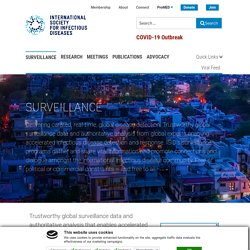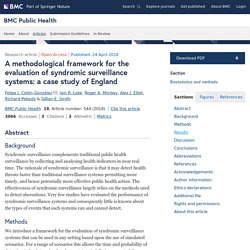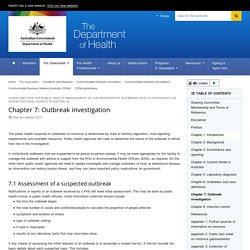

National Notifiable Diseases Surveillance System (NNDSS) About - GPHIN - Canada.ca. Surveillance - ISID. Cookies are pieces of data that a website transfers to a user’s hard drive for record-keeping purposes.

Web beacons are transparent pixel images that are used in collecting information about website usage, e-mail response and tracking. The website uses cookies to provide enhanced functionality on the site (e.g., user ID and password prompts, and conference registration) and aggregate traffic data (e.g., what pages are the most popular). CDC Surveillance Resource Center. MediSys - MainSys. MediSys. "كلمة" يطلق سلسلة ترجمات عن الأوبئة أبوظبي في الأول من أغسطس / وام /أطلق مشروع "كلمة" للترجمة في دائرة الثقافة والسياحة - أبوظبي مبادرة لترجمة مجموعة من الكتب التي تتناول الأمراض والأوبئة، في الماضي والحاضر، بهدف زيادة الوعي الصحي، وتطوير المعارف المتعلّقة بالأمور الصحيّة، وتحفيز الجمهور على اتباع نمط حياة صحي مستدام ينعكس إيجابياً.......

"The word" called a series of translations of epidemics Abu Dhabi on the first of August, mother" project was launched "a word of translation in the culture and tourism - Abu Dhabi the initiative to translate a group of books dealing with the disease and epidemics, past and present, in order to increase health awareness and the development of knowledge on health matters, stimulating the public to follow the pattern of life of a sustainable health reflected positive.... Department of Health. Department of Health. Spotlight: Smartphones Connect Disease Data Faster. Syndromic Surveillance (SS) The PHIN Messaging Guide for Syndromic Surveillance: Emergency Department, Urgent Care, Inpatient and Ambulatory Care Settings, Release 2.0 (April, 2015) is now available on the National Syndromic Surveillance Program (NSSP) Website ( Public health syndromic surveillance using inpatient and ambulatory clinical care electronic health record (EHR) data is a relatively new practice.

As eligible health professionals and hospitals adopt, implement, and upgrade their EHR systems through the CMS EHR Incentive programs (Meaningful Use programs), there is an opportunity for public health agencies (PHAs) to routinely receive health data from settings other than emergency departments and urgent care centers. Given the number of factors and complex relationships that affect EHR data quality, a collaborative approach that includes public health, healthcare, and EHR technology developers is the best way to determine how EHR data can be meaningfully used for surveillance.
A methodological framework for the evaluation of syndromic surveillance systems: a case study of England. 1Triple S Project.

Assessment of syndromic surveillance in Europe. Lancet. 2011; 378:1833–4.Article Google Scholar 2Buehler JW, Whitney EA, Smith D, Prietula MJ, Stanton SH, Isakov AP. Australia's capacity to respond to an infectious disease outbreak. Research paper Index Research Paper no. 3 2004–05 Critical, but stable Australia's capacity to respond to an infectious disease outbreak Nigel Brew Foreign Affairs, Defence and Trade Section Kate Burton Social Policy Section 16 November 2004 Contents Executive summaryIntroduction Responsibility for public health: the historical context The evolution of Commonwealth quarantine powers A national health department Infectious disease control today.

Department of Health and Human Services Victoria. National health security agreement. Transforming Environmental Health Protection. Chapter 7: Outbreak investigation. The public health response to outbreaks of norovirus is determined by state or territory legislation, local reporting requirements and available resources.

Public health agencies will seek to determine the nature of the outbreak to define their role in the investigation. In institutional outbreaks that are suspected to be person-to-person spread, it may be more appropriate for the facility to manage the outbreak with advice or support from the PHU or Environmental Health Officers (EHO), as required. On the other hand, public health agencies will need to rapidly investigate and manage outbreaks of food- or waterborne disease, as intervention can reduce human illness, and they can have important policy implications for government. Outbreak of Legionnaires' disease in Melbourne. Flesh-eating ulcer's spread to new part of Australia worries infectious disease experts.
The spread of a severe tissue-destroying ulcer once rare in Australia to a new geographic area in Queensland has infectious disease experts worried.

The Buruli ulcer, also known as the Bairnsdale ulcer or Daintree ulcer, is an infection that eventually leads to an eruption of painful skin ulcers that fail to heal. There have been no reported cases in New South Wales, South Australia or Tasmania, with the disease so far confined to the Douglas Shire in far north Queensland between Mossman and just beyond the Daintree River, and to Victoria’s Bellarine and Mornington peninsulas. Ross River virus: 150 more victims in Victoria as outbreak tally tops 1000.
Chief health officer Charles Guest said 1012 was nearly 10 times greater than the number of infections seen after major flooding in 2010 when there were only 103 notifications recorded.

"Recent rain and relatively warm weather has created conditions ideal for mosquito breeding and we have seen a major increase in mosquito numbers as a result," he said. "This summer, we are now seeing the biggest increase of Ross River virus cases since the last major floods of 2010. " Symptoms include fever, headache, aching muscles, joints and fatigue.
Is climate change causing a rise in the number of mosquito and tick-borne diseases? Life in a single-family home in suburban America, one with a quiet and spacious backyard, surrounded by natural habitats, lush green vegetation, where beautiful birds, squirrels and other small mammals come and go, is the American dream.

AUSTRAUMAPLAN – Domestic Response Plan for Mass Casualty Incidents of National Consequence. Australian Government Department of Health. Introduction to Incident Management. Introduction to the Incident Command System (ICS) Incident Command System Table Top Exercise. Incident Command & Mass Casualty Incidents for EMS Providers Lecture. Visual guide: how explosion caused mass casualties and devastation across Beirut. At least 100 people have been killed, 4,000 injured and dozens of buildings damaged after a massive explosion ripped through Beirut’s port and surrounding area.

Lebanon is reeling from the extensive damage caused by the explosion on Tuesday evening, with the port area flattened and buildings further into the city’s residential neighbourhoods damaged. Efforts to treat the injured have been hampered by the fact that hospitals are among the damaged buildings. The blast was so powerful it was felt in Cyprus, 120 miles (193 km) away. Lebanon president, Michel Aoun, said 2,750 tonnes of ammonium nitrate had been stored unsafely in a warehouse for six years. After an initial blast and fire in the port, it is thought that this was the cause of a second blast, with a massive fireball and white cloud sending a shockwave across the city.
Anger in Beirut after missed warnings over 'floating bomb' Anger and dismay has been building in Beirut as officials admitted that a massive port explosion that killed at least 135 people, injured thousands and left many more homeless was foreseeable and had been the subject of repeated warnings. With Lebanon’s capital still smouldering, an emerging paper trail linked the blast to a mammoth stash of ammonium nitrate that was once described as a “floating bomb” and housed at the port since 2014. As recently as six months ago, officials inspecting the consignment warned that if it was not moved it would “blow up all of Beirut”.
The revelation that government negligence may have played a role in the worst explosion in Beirut’s history fuelled new anger towards Lebanon’s political class among a population already seething at an ongoing financial crisis that has sunk half the country into poverty. The death toll climbed to more than 135 people according to the Lebanese Red Cross with another 4,000 wounded. Beirut explosion raises fresh concern about Newcastle's much larger ammonium nitrate stockpile - ABC News. Orica's safety record under fire after leak - ABC News.